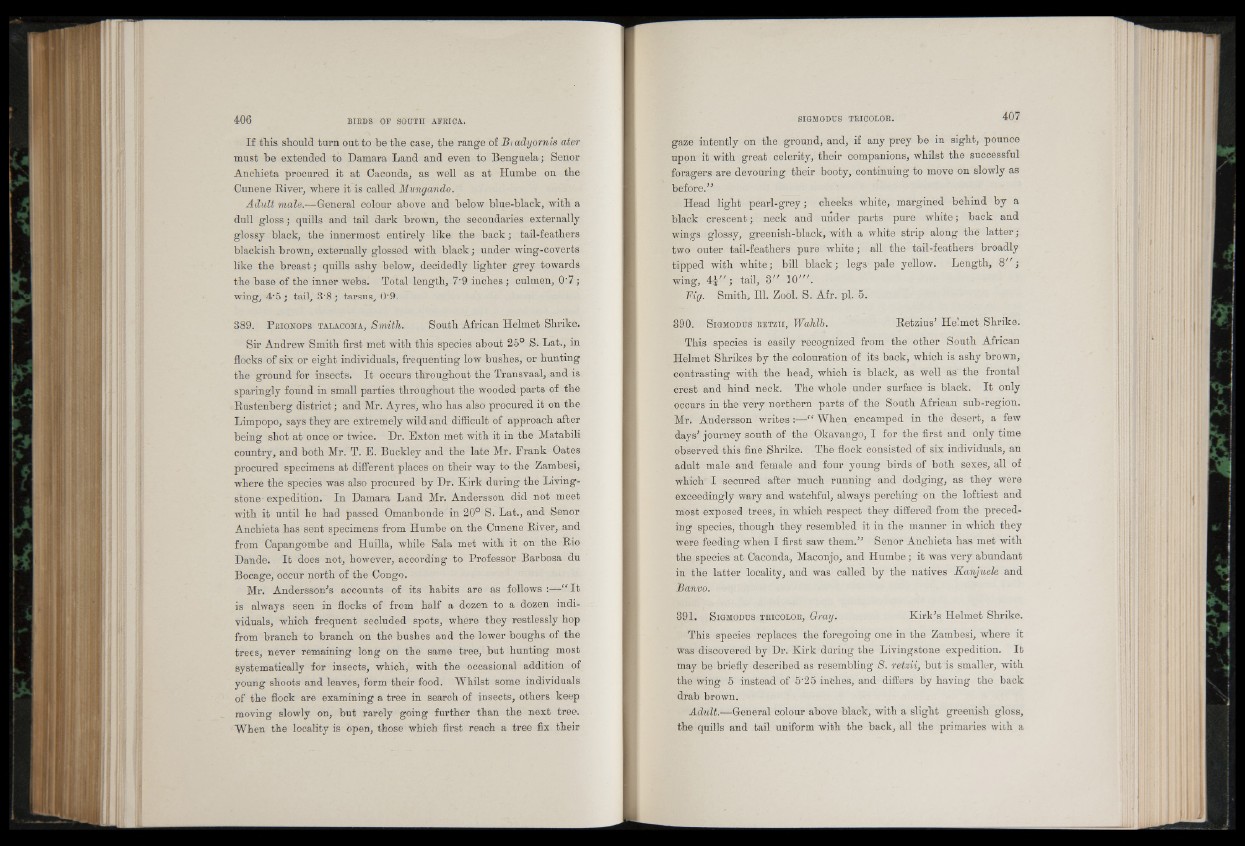
If this should turn out to he the case, the range of Biadyornis ater
must be extended to Damara Land and even to Benguela; Senor
Anchieta procured it at Caconda, as well as at Humbe on the
Cunene River, where it is called Mungando.
Adult male.—General colour above and below blue-black, with a
dull gloss; quills and tail dark brown, the secondaries externally
glossy black, the innermost entirely like the back; tail-feathers
blackish brown, externally glossed with black; under wing-coverts
like the breast; quills ashy below, decidedly lighter grey towards
the base of the inner webs. Total length, 7-9 inches ; culmen, 0'7;
wing, 4‘5 ; tail, 3‘8 ; tarsus, 0‘9.
389. P b io n o p s t a l a c o m a , Smith. South African Helmet Shrike.
Sir Andrew Smith first met with this species about 25° S. Lat., m
flocks of six or eight individuals, frequenting low bushes, or hunting
the ground for insects. It occurs throughout the Transvaal, and is
sparingly found in small parties throughout the wooded parts of the
Rustenberg district; and Mr. Ayres, who has also procured it on the
Limpopo, says they are extremely wild and difficult of approach after
being shot at once or twice. Dr. Bxton met with it in the Matabili
country, and both Mr. T. E. Buckley and the late Mr. Erank Oates
procured specimens at different places on their way to the Zambesi,
where the species was also procured by Dr. Kirk during the Livingstone
expedition. In Damara Land Mr. Andersson did not meet
with it until he had passed Omanbonde in 20° S. Lat., and Senor
Anchieta has sent specimens from Humbe on the Cunene River, and
from Capangombe and Huilla, while Sala met with it on the Rio
Dande. It does not, however, according to Professor Barbosa du
Bocage, occur north of the Congo.
Mr. Andersson’s accounts of its habits are as follows :—“ It
is always seen in flocks of from half a dozen to a dozen individuals,
which frequent secluded spots, where they restlessly hop
from branch to branch on the bushes and the lower boughs of the
trees, never remaining long on the same tree, but hunting most
systematically for insects, which, with the occasional addition of
young shoots and leaves, form their food. Whilst some individuals
of the flock are examining a tree in search of insects, others keep
moving slowly on, but rarely going further than the next tree.
When the locality is open, those which first reach a tree fix their
gaze intently on the ground, and, if any prey be in sight, pounce
upon it with great celerity, their companions, whilst the successful
foragers are devouring their booty, continuing to move on slowly as
before.”
Head light pearl-grey; cheeks white, margined behind by a
black crescent; neck and under parts pure white; back and
wings glossy, greenish-black, with a white strip along the latter;
two outer tail-feathers pure white; all the tail-feathers broadly
tipped with white; bill black; legs pale yellow. Length, 8 " ;
wing, 4 i" ; tail, 3" lO'".
Fig. Smith, 111. Zool. S. Afr. pi. 5.
390. S i g m o d u s r e t z i i , Wahlb. Retzius’ Helmet Shrike.
This species is easily recognized from the other South African
Helmet Shrikes by the colouration of its back, which is ashy brown,
contrasting with the head, which is black, as well as the frontal
crest and hind neck. The whole under surface is black. It only
occurs in the very northern parts of the South African sub-region.
Mr. Andersson writes When encamped in the desert, a few
days'1 journey south of the Okavango, I for the first and only time
observed this fine Shrike. The flock consisted of six individuals, an
adult male and female and four young birds of both sexes, all of
which I secured after much running and dodging, as they were
exceedingly wary and watchful, always perching on the loftiest and
most exposed trees, in which respect they differed from the preceding
species, though they resembled it in the manner in which they
were feeding when I first saw them.” Senor Anchieta has met with
the species at Oaconda, Maconjo, and Humbe; it was very abundant
in the latter locality, and was called by the natives Kanjuele and
Banvo.
391. S i g m o d u s t r i c o l o r , Gray. Kirk’s Helmet Shrike.
This species replaces the foregoing one in the Zambesi, where it
was discovered by Dr. Kirk during the Livingstone expedition. It
may be briefly described as resembling S. retzii, but is smaller, with
the wing 5 instead of 5‘25 inches, and differs by having the back
drab brown.
Adult.—General colour above black, with a slight greenish gloss,
the quills and tail uniform with the back, all the primaries with a